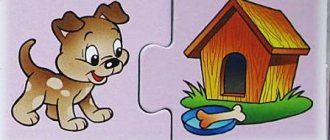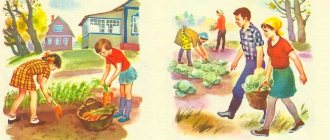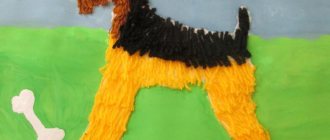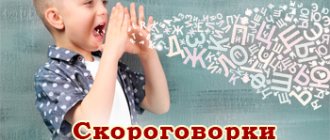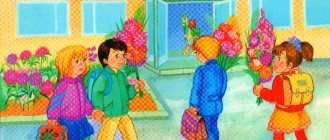Quiz with answers “Animals of the forest” for elementary school students, grade 2
Quiz on the topic “Animals of the forest” for elementary school students
Quiz about forest animals for the lesson about the world around us for 2nd grade
Author: Nadezhda Vladimirovna Ryabichenko, primary school teacher of the Mikhailovskaya Secondary School, Kikvidzensky District, Volgograd Region Brief description: This quiz is intended for 2nd grade students. It can be carried out in a lesson on the surrounding world when reinforcing the topic “Animals of forests”, as well as at extracurricular events, for example, when conducting a subject week on the surrounding world. Goal: to consolidate and expand children’s knowledge about forest animals. Objectives: - to form children’s ideas about the life of forest animals; — develop cognitive and creative activity, intelligence, curiosity, and horizons; — to cultivate a feeling of love for our native nature, for all living things. Equipment: pictures of forest animals. Hello, forest, dense forest, Full of fairy tales and miracles! What are you making noise about in the leaves on a dark, stormy night? What are you whispering at dawn, covered in dew like silver? Who is hiding in your wilderness? What kind of animal? What bird? Open everything, don’t hide it: You see, we are our own! (Author: S. Pogorelsky)
Quiz questions
Animals of the forest
1. This forest animal is active at night. To defend itself from an enemy, it can curl up into a ball. They say about it “gingerbread man - prickly side”. (hedgehog) 2. People call her “the red cheat”, she is the most cunning animal in the forest. (fox) 3. They are called “forest giants”. Large wide horns are a real decoration of these animals. (moose)
4. This forest predator is called the “forest orderly” because it destroys weak and sick animals. (wolf) 5. And this animal is very large and seems clumsy. But actually it is not. It can run quickly, almost silently, can climb trees and swim perfectly. (brown bear) 6. This seemingly calm animal can become angry and ferocious in a moment of danger. He loves to swim in a dirty puddle, but not because he is dirty. This is simply how he gets rid of the insects that have settled in his bristles, and also saves himself from the heat. (boar, pig)
7. This forest animal with a fluffy tail is very fast and agile. It can deftly jump on tree branches and is very fond of nuts and seeds from spruce or pine cones. (squirrel) 8. This animal is similar to a squirrel, only smaller. His ears are short and without tufts. On the back and sides there are black stripes along the body. Who is this? (chipmunk)
9. Name the animal of the forest, which people called “scythe” because its large eyes are on the sides of its head. Therefore, he sees not only what is happening in front of him, but also what is on the sides and even behind. (hare) 10. An animal with very valuable fur. This predator is an enemy of squirrels because it is nocturnal and while the squirrel is sleeping in its nest, it can get close to the nest and grab the sleeping animal. (marten)
11. Predator, looks like a cat, but much larger. It lies in wait for its prey, and when it sees it nearby, it silently creeps up and jumps on it. (lynx)
Birds of the forest
1. A bird that breeds its offspring in winter. (crossbill)
2. A bird of prey, which is popularly called the “forest cat.” (owl) 3. Name a forest bird that never builds its own nest or hatches its chicks, because it skillfully places its eggs in the nests of other birds. (cuckoo) 4. The best singer in the forest. (song thrush) 5. Name a forest bird that can deftly move upside down along tree trunks. (nuthatch)
6. The singing of this bird resembles the sound of a pipe. (waxwing) 7. This bird is called the “forest doctor.” With strong blows of its beak, it is able to break the bark of trees and extract various insects and their larvae from under the bark. (woodpecker) 8. Name a bird that imitates the voices of many other birds. (starling) 9. This forest bird in captivity can pronounce words or even melodies of songs. (jay)
10. Her gentle voice is like the ringing of a bell. (robin, or robin)
Forest insects
1. These insects are tireless workers. They are always at work. To build their house, they bring twigs, leaves, pine needles, and moss. (ants) 2. The larva of this insect lives in the bark of a tree and gnaws winding passages in it, which causes harm to the trees. (bark beetle)
3. This beetle has powerful jaws on its head that look like horns. (beetle - deer) 4. A predatory beetle that got its name because it can run very fast. (beetle - jumper) 5. This insect builds its home from leaves, cutting out ovals from them and transfers them to its nest. (leafcutter bee) 6. This beetle can be very easily recognized by its long mustache. That's why it is sometimes called the barbel. This beetle sharpens the wood of trees with its jaws. (woodcutter beetle)
We recommend watching:
Game-quiz on life safety for grade 4. Quiz with answers on Pushkin's works for grades 2-3. Quiz with answers on Perrault's fairy tales for elementary school. Quiz with answers for students in grades 2-4. Heroes of Pushkin's fairy tales
Similar articles:
Quizzes for schoolchildren with answers. Quiz on the topic: Pisces
Quizzes for schoolchildren with answers. Quizzes on the topic: Insects
Quiz for elementary school with answers. Quiz on the topic: Fairy tales
Quiz for elementary school. Quiz on the fairy tale Golden Key
Quiz for elementary school. Quiz on Andersen's fairy tales
Presentation of wild animals of our forest and their cubs presentation of the world around us
Slide 1
“Forest round dance” – wild animals of our forest and their cubs.
Slide 2
System of continuous educational activities
Slide 3
The goal is to consolidate children’s knowledge about wild animals, their cubs, and their place of residence. Expand and activate the vocabulary on this topic. Teach to distinguish different animals by their characteristic features. Objectives: Educational: - continue to expand and activate children’s vocabulary on this topic; - help children use in speech nouns in singular and plural form, denoting animals and their cubs (bear - bear cub - cubs). Developmental: - continue to develop thinking, attention, visual perception. Educational: - continue to develop interest in wildlife; — cultivate a sensitive attitude towards wild animals, a desire to help; - observe animals without disturbing or harming them.
Slide 4
Social and personal development Artistic and aesthetic development Cognitive and speech development Socialization Labor Safety Art. creativity Music Cognition Communication Reading fiction D/i “Wild animals”, p/i “Animals”, p/i “Journey to the forest”, p/i “Hares and the wolf”, “Crawl through the hole”, “Collect nuts”. A walk through a fairytale forest - helping our little brothers Reading and discussing the fairy tale “The Wolf and the Seven Little Goats.” Observe animals without disturbing them. Collective composition “Who Lives in the Forest”, modeling “Bunny”, applique “Squirrel”, drawing “Bear”. Listening to the sounds of wildlife, listening to “Bunny” music. L. Lyadova, “Bear”, music. E. Tilicheeva How do animals prepare for winter? Wild animals - expand your understanding of wild animals A story about animals with the help of a teacher “Exercises for animals” Reading Russian folklore. Fairy tales “Three Bears”, “Fox and Wolf”, “Mitten”, poem by A. Blok “Bunny”
Slide 5
Bear Move away from the den. Get off your feet quickly, or else I'll start crying. I'm not a hedgehog, but... (Bear)
Slide 6
The bear cub was born in a den, Now he sleeps and knows no anxiety. Why does he need to crawl out of his den in the winter cold? BEAR CUB - BEAR CUB
Slide 7
He looks like a shepherd. Every tooth is a sharp knife! He runs, baring his mouth, ready to attack the sheep. (Wolf) WOLF
Slide 8
WOLF CUB - WOLF CUB Even wolves do not growl or grumble when they are wolf cubs. They love and care, teach them to hunt.
Slide 9
FOX A cunning cheat, Red head, Fluffy tail - beauty, And her name is ... (Fox)
Slide 10
FOX CUB - FOX CUB The foxes dug a hole and brought out the little foxes. Who is closer and dearer to them? Dad is happy, mom is too, licks the babies with her tongue, feeds them with warm milk.
Slide 11
HARE It is dangerous to play hide and seek with him. The poor thing rushes without looking back. The trail got confusing and lay down: I was able to deceive the fox. (Hare)
Slide 12
Bunny - Bunny Stop, little bunny, don't run along the narrow path. You better take care of your little short tail. The fox is sneaking along the path, It’s unlikely that he’s looking for mushrooms!
Slide 13
SQUIRREL Sometimes red, sometimes gray, but by name white. (Squirrel)
Slide 14
CHILD SQUIRREL - CHIPPED SQUIRREL A hollow serves as their home - It is cozy and warm. You can sleep, or you can eat - There are not enough reserves there. I'll give you a hint: these nice little animals are not great. Children's ears and squirrels have tassels sticking out.
Slide 15
HEDGEHOG A ball is rolling through the forest, It has a prickly side. He hunts at night for bugs and mice. (Hedgehog)
Slide 16
HEDGEHOG - HEDGEHOG wolves are not afraid of hedgehogs, since mother has needles.
Slide 17
ELK Touching the grass with its hooves, a handsome man walks through the forest, walking boldly and easily, with his horns spread wide. (Elk)
Slide 18
CALF - ELSE CALFS The moose cow gave birth to a calf. He doesn't have much strength yet. And in the forest there are wolves, a lynx, a wolverine, so he clings to his mother out of fear.
Slide 19
The animals in the forest have children - fidgety, naughty ones. Baby squirrels are playing with burners. The baby squirrels just can’t sit still. They are not afraid of hurting themselves on the trunk. The mother bear has shaggy, thick-footed cubs that sleep in the den until spring, and probably don’t want to eat. The fox's cub is as cunning as an imp. He will play pranks, and then sweep everything away with his tail. The little bunny is sleeping soundly under the bush under the hare. The wolf will not catch the bunny, the mother protects the bunny. Don’t touch the wolf bunny, it’s better to run to the wolf cub. Your little son waited for you in the hole at dawn. And there’s a little mouse in the mouse’s hole. He rubs his eyes and squints sleepily. Mothers love them very much, their little children. They will scratch their back and smooth their bristles, they will wash them with their tongue and give them milk to drink. They will caress you, take care of you, put you to sleep and wake you up, When the sun rises, a new day calls with you.
Slide 20
FOREST ROUND DANCE The rain dripped, dripped, dripped - the Hedgehog got wet and cried. The scratching squirrels are right there, grabbing the unfortunate man by the paws. The wild boars ran past - They took the squirrels by the palms. Two foxes grabbed those boars by the hooves. Bunnies joined them, moose joined the hares, then beavers. Behind the beavers, two martens clung to the line. And then the deer, the little mice, the weasel, the lynx and the bear cubs, the toothy wolf, the old mole, stood together in a round dance. In the clearing the circle has closed. The hedgehog sobbed and smiled. Well done! How else?! Everything is together and the hedgehog doesn’t cry!
Slide 21
THANK YOU FOR YOUR ATTENTION
Abstract “Animals of our forests”
Summary of educational activities with preschoolers in a mixed age group
Abstract of OD for children of different age groups of preschool educational institutions: “Animals of our forests”
Description:
This summary will be of interest to teachers of preschool institutions and teacher organizers.
We spent it with children of the second younger group and with children of the older group. Goal:
to summarize children’s knowledge about the life of forest animals.
Objectives
of the lesson: Cognitive: • Clarify children’s understanding of forest animals.
• To consolidate children's knowledge about the life of wild animals in the forest, their habitat, and the method of obtaining food. Developmental: • Expand and activate vocabulary on the topic “Wild Animals”. • Develop memory, logical thinking, communication skills. Educational: • Cultivate curiosity. • Foster a caring attitude towards nature. Preliminary work.
• Conversations about wild animals. • Reading fiction • Looking at pictures and plots on the topic “Wild Animals”.
The music "Sounds of the Forest" is playing. Educator:
Guys, close your eyes and listen carefully to the music.
What do you think it's about? Answers. Educator:
Why did you decide that this is music about the forest?
Answers. Educator:
Well done.
Can you name who lives in the forest? Answers. Educator:
What do we call them, in one word?
Answers. Educator:
That's right, these are animals.
What kind of animals are these if they live in the forest? Answers. Educator:
I invite you to the clearing, I suggest you play.
FOREST BEASTS
One, two, three, four, five - What should we call the animals?
(Walk in place) They don’t know people, they live in the forest, they hide. (Clap your hands) Everyone knows them from the pictures: (Fold your palms in the form of a book) Wolf, fox, bear and hare. (Curb your fingers, counting) Their house is thick thickets. (Show the roof above your head with your hands) Wild, forest animals. (Raise your hands with your fingers spread) Educator:
What do they eat?
Children
talk.
Educator:
Will we guess riddles about animals?
Answers. Educator:
He's furry, he's big,
He sleeps in a den in winter. In summer he chews berries and takes wild honey from bees. The clubfooted beast can roar menacingly... (bear)
- Red - a fiery ball, With a tail like a parachute, Jumps quickly through the trees, He was there... Now he’s here. He is as fast as an arrow, so this is... (squirrel)
— The red-haired cheat hid under the tree. That cunning hare is waiting for the hare, and her name is... (fox)
- The gray one is chasing the white one, wants to have white dinner. As soon as he catches up, he clicks his teeth: White - poor, well-fed... (wolf)
- A ball of fluff, a long ear. Jumps deftly, Loves carrots... (hare)
— Lying between the fir trees, a pillow with needles. She lay quietly, Then suddenly she ran away... (hedgehog)
— Touching the grass with his hooves, a handsome man walks through the forest. Walks boldly and easily, horns spread high... (moose)
- Branches crunch in the forest, Here and there. Looking for acorns... (boar)
Educator:
What a great fellow you are.
All the riddles were solved. Now I suggest you play a little. Go out into the clearing, your legs and arms are ready. Listen and follow through. The hares got up early in the morning.
The hares got up early in the morning. They played merrily in the forest.
Jump-jump-jump along the paths! Who is not used to charging? (Jumping in place.) Here is a fox walking through the forest. Who's jumping there, I wonder? (Walk in place.) To answer the question, the little fox pulls his nose. (Stretching - arms forward.) But the bunnies jump quickly. How could it be otherwise? (Jumping in place.) Training helps! And the bunnies run away. (Running in place.) Here is a hungry fox (Walking in place.) Looking sadly at the heavens. (Stretching - arms up.) Sighs heavily, (Deep inhalation and exhalation.) Sits down, rests. (Children sit at the tables.) Educator:
Now look at the picture and name the extra animal?
Answers. Educator:
We continue to play and call the animals mommy.
“Name your mother...”
The little hare...(hare) The little squirrel...(female squirrel) The little wolf...(female wolf) The little fox...(fox) The little elk...(moose) The bear cub...(mother bear)
Educator:
And again I invite you to play.
Hares and a wolf
One of the players is chosen to be a wolf.
The rest of the children pretend to be hares. On one side of the site, the hares make houses (hoops) for themselves. At the beginning of the game, the hares stand in their houses; the wolf is at the other end of the site (in the ravine). The teacher
says: The hares gallop, hop, hop, hop, onto the green meadow, nibble the grass, eat, listen carefully to see if a wolf is coming.
Hares jump out of the houses and scatter around the site. They either jump on two legs, then sit down, nibble the grass and look around to see if the wolf is coming. When the teacher says the last word, the wolf comes out of the ravine and runs after the hares, trying to catch (touch) them. The hares each run away to their own house. The wolf takes the caught hares into the ravine. As soon as the wolf leaves, the teacher repeats the text of the poem, and the game resumes. After 2-3 hares are caught, another wolf is chosen. Educator:
We’ve already played enough, we’ve remembered different animals, we suggest sitting down on chairs at the tables and doing finger exercises.
“Hedgehog”
The little hedgehog froze and curled up into a ball.
(press your fingers, imitating pressed needles) The sun warmed the hedgehog - the hedgehog turned around. (straighten your fingers, straightening the needles) Educator:
And now rest. We offer coloring pages to the sounds of calm music.
